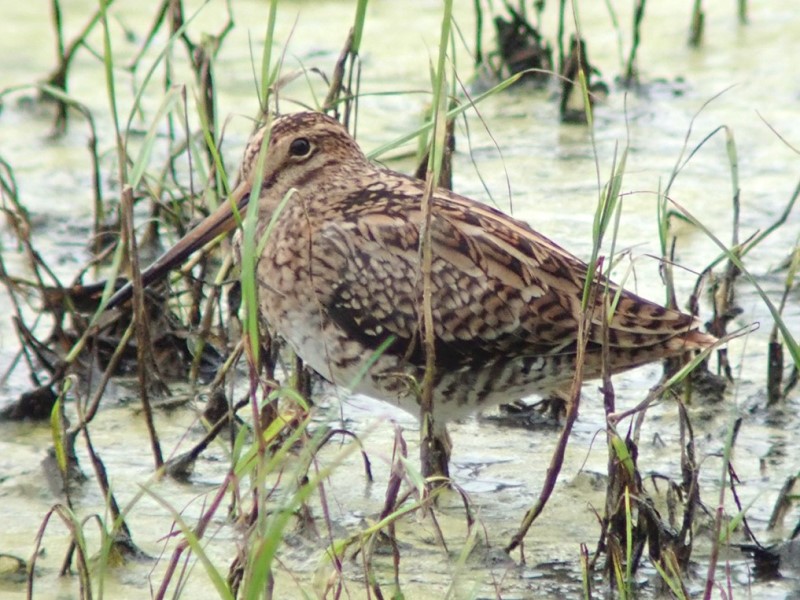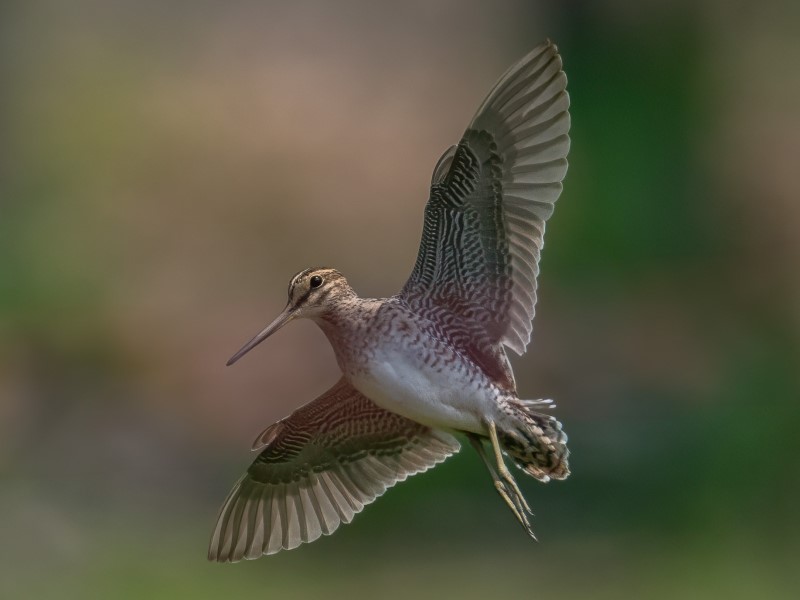Swinhoe’s Snipe Gallinago megala 大沙錐
Category I. Uncommon passage migrant and scarce winter visitor to freshwater marsh and wet agricultural fields.
IDENTIFICATION

Nov. 2019, Matthew Kwan.
Differs from Common Snipe in having the supercilium broader than the eye and crown stripes at the base of the bill, a pale panel across the median upperwing coverts in flight and virtually no white trailing edge to the secondaries. Juvenile has whitish-buff fringes to wing coverts and tertials. Flushes less readily than both Common and Pin-tailed Snipe and geneerally has a less erratic flight.

Apr. 2024, Robert Hackel.
Very similar to Pintail Snipe but differs in having only 20-22 rectrices and lacking the pin-like outer tail feathers; instead, the outer 5-7 pairs gradually get narrower. Possibly has a shorter foot projection beyond tail in flight and a longer bill. Call is different, with that of Swinhoe’s being notably lower in pitch (see below).
VOCALISATIONS
The typical flight call when flushed is notably deeper and throatier than both Common and Pin-tailed Snipes.
DISTRIBUTION & HABITAT PREFERENCE
Based on hunting records Aymas (1930) stated that Swinhoe’s Snipe did not frequent rice paddy but was found in ‘marshy ground and the borders of streams’, in sweet potato fields in rainy weather and even on the side of small grassy hills in long grass.
Most records of snipe now come from the wet agriculture and freshwater marsh area at Long Valley and the freshwater or brackish water ponds at Mai Po NR.
OCCURRENCE
Birds for which the identity has been confirmed in the hand have occurred on 20 January, 3 February, from 31 March to 8 April and from 28 August to 22 October. The peak month is September, though this is related at least in part to trapping activity. This does not match the observations of Aymas (1930) who, based on hunting records, regarded Swinhoe’s Snipe as only visiting in spring from the last week of March and the end of April. Historically, Vaughan and Jones (1913) noted that this was the rarest of the three Gallinago snipes and had been obtained in the period from 26 August to 17 May, though chiefly in April; none were thought to spend the winter in HK.
BEHAVIOUR, FORAGING & DIET
Feeds by inserting its bill into soft mud feeling for prey. As with all snipe in HK, generally seen as it is flushed from diurnal roost sites, when it may utter its distinctive call.
RANGE & SYSTEMATICS
Monotypic. Breeds mainly in south central Siberia and north Mongolia, with a disjunct population in Ussuriland; winters in south and northeast India, Myanmar, south China, the Philippines, Indonesia south to northern Australia (Van Gils et al. 2020). In China a migrant through the east and south, wintering in southeast coastal provinces including Hainan (Liu and Chen 2021).
CONSERVATION STATUS
IUCN: Least Concern. Population trend unknown.
Aymas (1930). Local game birds. The snipe. Hong Kong Naturalist 1: 112-113. (Aymas was the pen-name of R.A. Pereira)
Liu, Y. and S. H. Chen (eds) (2021). The CNG Field Guide to the Birds of China (in Chinese). Hunan Science and Technology Publication House, Changsha.
Van Gils, J., P. Wiersma, and G. M. Kirwan (2020). Swinhoe's Snipe (Gallinago megala), version 1.0. In Birds of the World (J. del Hoyo, A. Elliott, J. Sargatal, D. A. Christie, and E. de Juana, Editors). Cornell Lab of Ornithology, Ithaca, NY, USA. https://doi.org/10.2173/bow.swisni1.01
Vaughan, R. E. and K. H. Jones (1913). The birds of Hong Kong, Macao and the West River or Si Kiang in South-East China, with special reference to their nidification and seasonal movements. Ibis 1913: 17-76, 163-201, 351-384.

